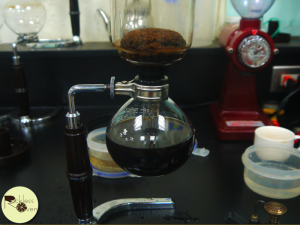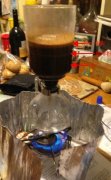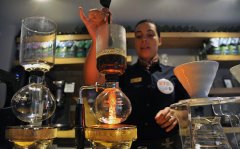For beginners to learn siphon coffee, you must see the principle of siphon coffee pot and teach the skills of siphon coffee brewing.

Professional coffee knowledge exchange More coffee bean information Please pay attention to coffee workshop (Weixin Official Accounts cafe_style)
Brew a cup of siphoning coffee at home
There are many ways to brew coffee, depending on personal preferences, habits, beans used, roasting and other factors have different brewing methods.
The laboratory record is an entry level, brewed by beginners from a more scientific point of view!
In the future, after a long time of brewing, there should be a deeper understanding of coffee beans and brewing methods, and a more familiar operation should develop different methods.
Siphon coffee pot, also known as Siphon/Syphon
Originated in Germany, it uses the pressure generated when water boils to cook coffee. The coffee pot is divided into two parts, the middle part is communicated by a conduit, and the filter cloth is padded in the hole between the upper pot and the lower pot to filter coffee grounds, and the metal hook connected with the filter cloth enables the water in the lower pot to be heated evenly. When the kettle is filled with hot water, heat it with small gas (alcohol lamp), so that the water is converted into water vapor, and the pressure on the water surface increases. Boiling water then enters through the conduit to hold the ground coffee. Then re-enter the lower part through the filter paper or filter cloth, and then drink.
Siphon coffee tastes different not only because of the coffee beans themselves, but also because of the temperature, time, and even the length of time the coffee is stirred. Siphon coffee generally uses medium/light roast coffee beans because its indirect warming and longer soaking methods can reflect the finer coffee layers and fruit sweetness, compared to heavy roast coffee aroma, oil aroma is different.
If overcooked in a siphon pot, it may appear
1. Bitterness: Excessive extraction (overcooking, or water temperature too high to cause the beans to burn)
2. astringency: prolonged soaking
3. Acidity: Acidity of the coffee bean itself, or spoilage caused by improper handling for too long, or it may be caused by different roasting degrees.
- Degree of coffee roasting: Coffee presents differently depending on the time and temperature of roasting.
Because coffee roasting changes, from temperature, time, and even the color of coffee beans, even if roasted to the same temperature, or even the same color, it is possible to present different tastes, generally roasting coffee, will be the first explosion of the second explosion (coffee beans because of the heat expansion of water evaporation, and produce explosive sound) with the conversion of coffee beans color control roasting degree (roasting curve is different).
The following provides a baking statement is palatable baking temperature range is 185--240 ℃, the average person can accept the appropriate baking temperature range of 210--230 ℃, more than 230 ℃ can be called overbaking.
- Light Roast: Coffee Roast Color Number 75--65
The first explosion (coffee due to heat expansion produced by the batch crackling sound) within about 30 seconds after the end of the degree (after the first explosion in the middle), showing a sweet taste with acidity, generally used for cup testing coffee beans essence quality.
- Medium roast: coffee roast color card number 65--55
30 seconds after the end of the first explosion to the extent that the second explosion has not yet occurred, it belongs to the full flavor taste, but also the best taste of caramel, which is the most common drink of consumers.
- Dark-1: Coffee Roasting Color Number 55--50
The second explosion (after the first explosion, a continuous batch of crackle explosion) begins to 30 seconds, caramelization effect, at this time the sweetness is most obvious, chocolate flavor, suitable for milk or espresso machine commonly used.
- Dark-2: Coffee Roasting Color Number 50--40
The second explosion 30 seconds to 60 seconds between the degree of chocolate-like sweet bitterness, acidity disappears, suitable for milk or espresso machine and other heavy flavors commonly used.
- Very Dark: Coffee Roast Color Number 40--35
The second explosion 60 seconds--90 seconds between the degree, the highest degree of pickled bitter aroma, applicable to iced coffee, milk and heavy taste commonly used.
(Baking beans, another day)
(Roasting color cards are infrared caramelization analysis numbers (Agtron numbers) promoted by the American Specialty Coffee Association (SCAA) to determine the degree of roasting, and their values range from 0 to 100, with higher values indicating lower caramelization, gray color, and lighter roasting, and vice versa. (SCAA/ Agtron Roast Color Classification System) )
Reckless Oven Beginner Siphon Coffee
Step 1: Prepare all equipment
Siphon pot, filter cloth, coffee beans, hot water (brewing speed can be accelerated), small gas (liquid gas supplement bottle), coffee beans, coffee spoon, stirring rod, timer, rag, bean grinder.
Step 2: Install filter cloth
The metal hook of filter cloth must be vertical and cannot be twisted and rolled together, otherwise it will cause uneven heating. The hook at the bottom of the metal chain should be hooked at the end of the upper pot pipe to fix the filter cloth. And the metal hook entanglement will cause too tight will lead to the brewed coffee body is insufficient, the so-called body is the successful extraction of fat in the coffee beans and brought into the next pot, so that when drinking coffee taste will not be water.
Step 3: Fill the kettle with hot water
(The amount of filling depends on the number of cups to be boiled and the amount of hot water to absorb powder. Generally, 120cc of water is a cup, corresponding to a scoop of about 7--11 g of coffee cooked beans.)
Step 4: Heating
Make sure the pot is dry before heating to avoid cracking due to uneven heating after heating. Siphon pot coffee cooking, generally will use alcohol lamps or mountaineering with a small gas stove, mountaineering with a small gas stove advantage is that you can control the size of the fire. Make sure there is enough gas in the stove before you start cooking. If it goes out in the middle of cooking, start over again!
Step 5: Heat to the bottom of the pot
In order to shorten the heating time of water, the gas stove can start a big fire at the beginning, and once all the water reaches the upper pot, the fire can be reduced, and the fire column can be adjusted to about the same thickness as the upper pot pipe. At the same time, let the water disturb for about 30- 60 seconds. Make sure that the convection of the water flow in the upper pot is stable and the heat is uniform. The judgment method is to observe the bubbles in the upper pot. Small and dense bubbles can be used. The recommended extraction temperature is 90- 92 degrees.
Controlling the firepower is also controlling the water flow, using the adjustment of the firepower of the gas stove to adjust the boiling degree of the residual water in the lower pot to control the generation of steam, and then controlling the degree of agitation of the water flow in the upper pot, and using the stable amount of steam generated by the stable firepower to provide stable agitation, so as to stabilize the extraction of coffee.
Step 6: Ground Coffee & Pour
When the gas fire is adjusted, it can be prepared for grinding. Coffee beans do not need to be ground too early, because too early grinding will cause aroma loss. The coffee powder thickness suitable for siphoning pot brewing is adjusted by the coffee grinder scale at 0.84mm(US standard 20 sieve; coffee powder passing rate 80--85%).
Once the grinding is done, and the disturbance of the upper pot is stable, the coffee powder can be poured into the upper pot in one breath. The appropriate extraction time is about 37 seconds after the coffee powder is poured. After the coffee powder is poured in, whisk it quickly with a stirring rod for about 3- 7 seconds to help wet the coffee powder for extraction. A successfully stirred coffee powder should have three layers, indicating that the substances in the coffee have been dissolved by stirring disturbance. (Only fresh coffee beans have successful layering)
Then wait for 37 seconds, put out the fire, hold the top edge of the pot, with a stirring rod deep into the pot and beat quickly, creating a stable vortex in the middle of the pot (In this way, the coffee powder will be concentrated on the filter cloth and present a semicircular sphere, which will not block the periphery of the lower edge of the upper pot, so that the grease of the coffee can flow down smoothly, and will not be blocked by the coffee grounds or the filter cloth. The grease of the coffee will make the coffee drink smoothly and not dilute). After taking away the fire source, the water vapor pressure caused by the heat source in the lower pot will be lost. The coffee in the upper pot will flow into the lower pot along the conduit. When the coffee flows into the lower pot about 1/4 height, you can stop stirring. And the use of ice cloth wrapped under the pot upper edge (water vapor concentrated here), so that you can accelerate the flow of coffee on the pot down, from the gap not wrapped to see the bubble on the water surface of the pot, the wet cloth to touch the bottom of the pot, the original fire heating cooling, at this time the water surface should begin to bubble white vigorously.
Another purpose of agitation is to extract the dissolved substances from the coffee particles. Use the principle of centrifugal force to shake the dissolved coffee liquid away from the coffee particles. The greater the centrifugal force, the easier it is to shake out and the more it is thrown out.
ž- Extraction process, coffee soluble substances are dissolved one by one according to their solubility, depending on the length of time. The dissolved coffee ingredients appear in the following order
- sour> sour> bitter> bitter
- It is suggested that the extraction time should be controlled between "sour> bitter", so that coffee has the variability brought by "acid", the irritation brought by "sour" and the representativeness brought by "bitter".
After cooking, it is best to turn the pot (shake well) so that the extracted substances of the cooked coffee are uniform.
Step 7: Taste-Smell & Smell
In fact, before brewing coffee, you can eat and see the roasted coffee beans, smell the coffee beans, smell the dry coffee powder after grinding, and then smell the wet coffee before drinking coffee, and then the first sip with a quick inhalation, you can smell different aromas. When the coffee is imported, you can pay attention to the taste of the taste and the taste of the taste, and the characteristic coffee will taste different in each mouthful, because the substances in the coffee react with saliva, so that each mouthful has a different feeling.
I wish you all the joy of making and tasting your own coffee--:
。
Important Notice :
前街咖啡 FrontStreet Coffee has moved to new addredd:
FrontStreet Coffee Address: 315,Donghua East Road,GuangZhou
Tel:020 38364473
- Prev

Romantic and elegant siphon coffee siphon coffee maker explains the difference between hand-brewed coffee and siphon
Professional coffee knowledge exchange more coffee bean information please follow the coffee workshop (Wechat official account cafe_style) alcohol lamp siphon coffee brewing complete tutorial, brewing a good cup of siphon coffee at home the romantic elegance of siphon coffee pot, very much in line with the aesthetic taste of the East. When you make a cup of coffee so carefully and carefully, you look at the crystal clear glass.
- Next

Analysis of the difference between hand-brewed coffee and siphon coffee is the taste of hand-brewed coffee and siphon coffee really very different?
Professional coffee knowledge exchange more coffee bean information please follow the coffee workshop (Wechat official account cafe_style) alcohol lamp brewing siphon coffee complete tutorial, brewing a good cup of siphon coffee at home uses the filter method, while siphon coffee is the combination of soaking method and filtration method, in fact, it can more highlight the flavor, but now the popular boutique coffee uses the filter method
Related
- What is the Philharmonic pressure? How to use Philharmonic pressure to make delicious coffee
- Why does a hand grinder have more fine powder than an electric grinder?
- In addition to the hot mom, what is the difference between the versions of EK43 | ditting and Mahdi ek43?
- What kind of equipment do you need to make coffee by hand? Introduction to novice starter cooking equipment tools
- Espresso needs to be ground how thick and thin scale entry Italian Coffee Machine Bean Grinder investigation and Grinding course
- How much does it cost to open a small private cafe? How much does it cost to learn coffee? How to operate it?
- The difference between the flavor characteristics of hand-brewed coffee and coffee maker is hand-brewed coffee really better than coffee maker? Can I use a coffee machine to make coffee beans by hand?
- The difference between 01 and 02 of hario v60 filter cup what is the difference between 01 and 02 filter cup opening and cooking flavor
- What's the difference between the smart cup and the French kettle? Which is better, the French kettle or the Smart Cup?
- What's the difference between a smart cup and a V60 filter cup? The difference between the taste of smart cup and hand-brewed coffee

